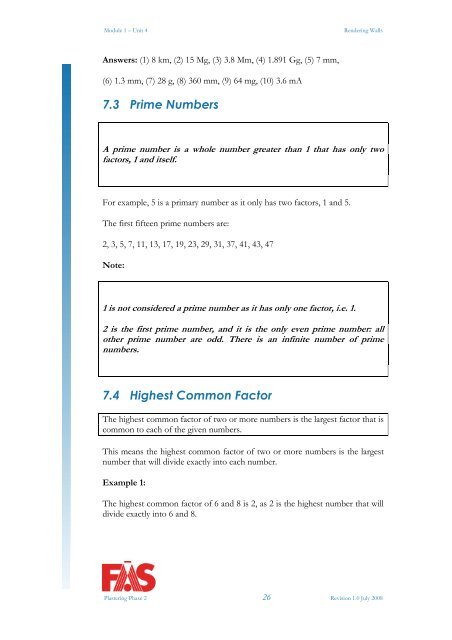TRADE OF PLASTERING - eCollege
TRADE OF PLASTERING - eCollege
TRADE OF PLASTERING - eCollege
You also want an ePaper? Increase the reach of your titles
YUMPU automatically turns print PDFs into web optimized ePapers that Google loves.
Module 1 – Unit 4 Rendering Walls<br />
Answers: (1) 8 km, (2) 15 Mg, (3) 3.8 Mm, (4) 1.891 Gg, (5) 7 mm,<br />
(6) 1.3 mm, (7) 28 g, (8) 360 mm, (9) 64 mg, (10) 3.6 mA<br />
7.3 Prime Numbers<br />
A prime number is a whole number greater than 1 that has only two<br />
factors, 1 and itself.<br />
For example, 5 is a primary number as it only has two factors, 1 and 5.<br />
The first fifteen prime numbers are:<br />
2, 3, 5, 7, 11, 13, 17, 19, 23, 29, 31, 37, 41, 43, 47<br />
Note:<br />
1 is not considered a prime number as it has only one factor, i.e. 1.<br />
2 is the first prime number, and it is the only even prime number: all<br />
other prime number are odd. There is an infinite number of prime<br />
numbers.<br />
7.4 Highest Common Factor<br />
The highest common factor of two or more numbers is the largest factor that is<br />
common to each of the given numbers.<br />
This means the highest common factor of two or more numbers is the largest<br />
number that will divide exactly into each number.<br />
Example 1:<br />
The highest common factor of 6 and 8 is 2, as 2 is the highest number that will<br />
divide exactly into 6 and 8.<br />
Plastering Phase 2 26 Revision 1.0 July 2008

















